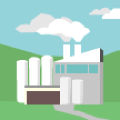Central Lower Hutt generally has good air quality all year round.
Sources of air pollution
-
In this town, where do emissions come from?
The split between home heating, industrial, outdoor burning and traffic sourcesShow Hide- Sources of PM10 emissions
- Sources of PM2.5 emissions
- Sources of NOx emissions
Source Annual percentage Winter day percentage  Home heating
Home heating
{{emissions.annualhome}}% {{emissions.winterhome}}%  Industrial
Industrial
{{emissions.annualindustry}}% {{emissions.winterindustry}}%  Outdoor burning
Outdoor burning
{{emissions.annualoutdoor}}% {{emissions.winteroutdoor}}%  Traffic
Traffic
{{emissions.annualmotor}}% {{emissions.wintermotor}}% Relative breakdownAnnual Winter day The table shows the proportions of the main sources of PM10, PM2.5 and nitrogen oxides (NOx) in this town from home heating, industrial activities, outdoor burning and traffic. (Indoor, natural and shipping sources are not included in this breakdown).
These values come from 2013 data sourced from MfE’s data service. Consistent methodology was used to calculate these estimates of PM and NOx emissions, which allows comparison between towns throughout New Zealand. Regional council or unitary authority published emissions information might differ if they were prepared in a different year or used another method. Contact your regional council or unitary authority for more information about PM and other emissions in your area.
Seasonal variation
- Show wind speed
- Show temperature
PM10 |
PM2.5 |
Wind speed (km/h) |
Air temperature (℃) |
What is this graph showing me?
The graph shows the monthly average PM concentrations at one representative site in this town for the year selected. In many towns in New Zealand, PM peaks in the winter when air temperatures and wind speeds are lowest as more people heat their homes during colder weather, and still conditions mean that there is no wind to disperse the air pollutants.
